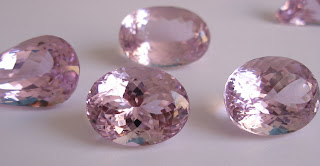
Morganite and kunzite are just really special stones -- especially if you like a real purdy light pink or violet. [Please click on the photo to enlarge it.]
The big trillion (ca. 54 cts.) morganite on the left has been irradiated. Notice it has been cut without a table. Personally, for morganite, which has an extra special brilliance compared to a beryl like aquamarine, I love this type of cut. It throws out flashes of light all over the place. On this trip, I didn't see treated morganite with horrible greyish tones. I was told (OK, time for a GOS -- grain of salt) that there is a new morganite treatment and that the stones were being sent to Germany for it, but who knows. This trillion had a very slight orangy tone to it, especially in low light or artificial light.
The second, smaller trillion is also morganite. I was told that it had not been treated (GOS). Its color is still very decent considering that its depth is so much less than the larger stone. Morganite is one of those stones that opens up when it is cut and can turn out a lot lighter than the rough appears to be. Notice that this stone's table gives it more of a window than the larger trillion.
The two trillions were most likely cut in Teófilo Otoni. A couple of years ago, I had some morganite rough cut just like the stone on the left, right across the street from where this photo was taken. It was over 40 carats when finished and was nearly completely branco ("white") or colorless, as we would say in English, although the rough was a light salmon pink.
[In Brazilian Portuguese, the color of transparent, colorless stones is referred to as branco. Although the words for "stone" (pedra) and "gem" (gema) are feminine in Portuguese, the word for "color" (cor) is masculine (or maybe just neutral), and since, in this case, branco is the adjective for cor, it ends in an "o" instead of an "a."]
The fat pear is a kunzite. I was told (GOS) that it was an untreated Brazilian kunzite. Kunzite is a really weird stone for cutters. It can be in the final polishing stage and just suddenly split in two. All that work for nothing. Nevertheless, they are cutting gobs of it in Governador Valadares (and I was also told that they mine it right around GV -- GOS alert), about 2 hours from Teófilo Otoni. And the cuts are so sparkly and beautiful that you could just drool over them.

Some years back, most of the kunzite I came across was emerald cut or a mixture of the emerald and scissors cut (as it is known here -- if anyone can tell me what the proper name is, please leave a comment). Those two cuts certainly do show off the strong concentration of color at the end of the crystals (oops, another vocabulary deficiency I hope to fix in the near future -- isn't it nice the way you can go back and change anything you want in a blog!), but they do not show off the brilliance and flashes. Let's just put it this way -- these fancy oval and pear cuts put a lot of life in kunzite that will never show up in an emerald cut.
Of course, my wimpy little amateur camera can't begin to show the beauty of these stones.
more later. . .
OK, so if you click on the photos, they will enlarge dramatically and show lots of details -- the flaws! Take a good look at the kunzite in the top photo. Rotate the photo 90° (or turn your head or whatever). Look at that little fissure on the bottom right, almost exactly where a prong might press if the stone is set.
For me, since this stone is a kunzite, I would have to reject it without another thought. I could be wrong (and I am often wrong, so feel free to comment if you think so), but since kunzite has that peculiar tendency to snap in two, I would not buy one with a fissure right in that spot (where a jeweler is going to have to apply some pressure with a prong) or maybe any spot at all -- why take the chance?
Copyright © 2009 N. Tenney Naumer -- All rights reserved.





No comments:
Post a Comment